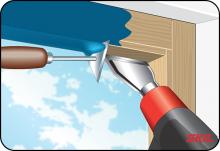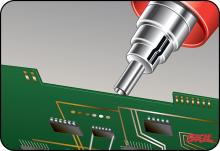-
The right temperature and airflow settings
The right temperature setting for a heat gun depends on the job. The airflow setting is important too. That depends on the material and how quickly you work. You get the best results with the right temperature and airflow settings. -
Generally, the heat gun’s highest temperature setting is suitable for soldering or thawing water pipes and can also be used to remove paint. The lower settings are ideal for drying paint and shaping plastic. Always run a test on an inconspicuous part of your workpiece at low temperature and gradually increase the temperature until you get the right result. That will depend on the job. When you’re removing lacquer or paint with a heat gun for example, you’ll see the paint softening up and bubbles beginning to form when the right temperature is reached. You’ll find it easy to scrape the paint off. If you want to solder copper pipes with a heat gun, you’ll know you have the right temperature as soon as the soldering wire starts to melt in the joints.
-
Again, to achieve the best results, various air flow settings should be tested on the heat gun. If you want to heat up a specific part of the work area, while soldering or welding small print plates, say, you will normally work with a low airflow. That’s because you won’t want to heat up the rest of the surface. If you use a heat gun to start a barbecue or burn off paint from a large surface area, a high airflow will work well for you. However, you’ll have to adjust the airflow as soon as you get close to fragile parts, for example when burning paint off a window pane.

